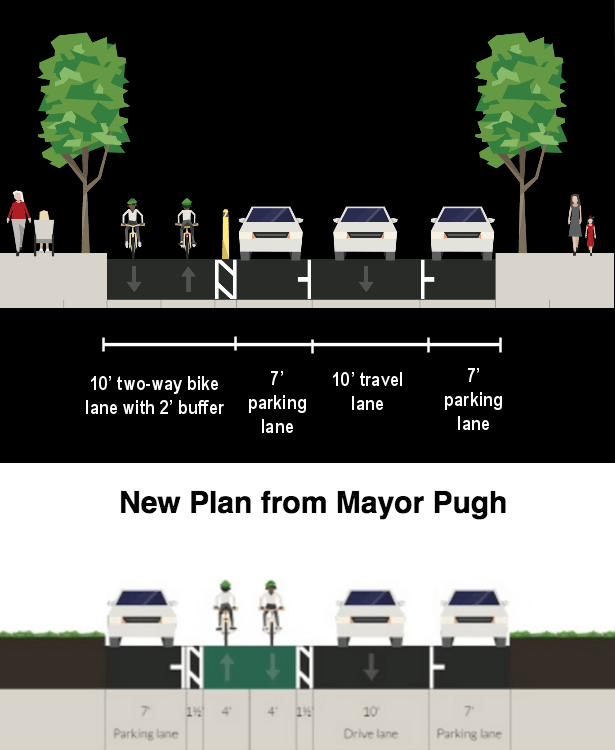Baltimore Mayor Catherine Pugh has given in to bikelash, downgrading a new protected bike lane while the city was in the process of installing it. Now, the bikeway will be redone as a patchwork of unprotected and too-narrow paths that fail to meet engineering standards -- while resulting in dangerously wide car lanes that encourage speeding. Just six months after she took office, once-hopeful advocates are left questioning the mayor's commitment to installing safe, properly-designed streets.
The bike lane, along a half-mile of residential South Potomac Street in the Canton neighborhood just east of downtown, connects Patterson Park with the Patapsco River. Construction began about four weeks ago, before it was halted two weeks later after some residents complained to the city.
“It sort of ran the gamut as to why constituents did not like the cycle track, but I would say that the majority of people in my district -- in Canton and outside of Canton -- supported it," said Councilman Zeke Cohen. Some opponents didn't like losing 10 parking spaces, he said, while others thought it was ugly.
But it was one particular objection that ended up turning Pugh against the bike lane, despite efforts by Cohen and others to save it. "There are firefighters that live on Potomac Street that used their knowledge of the International Fire Code to lobby the fire marshal," said Liz Cornish, executive director of advocacy group Bikemore. "That really puts the city in a difficult position.”
Specifically, the code mandates 20 feet of unobstructed width for full-size fire trucks to navigate a street -- a suburban-style requirement that's sometimes cited by urban fire departments to argue against safer street designs.
Somehow, the insistence on 20-foot widths for fire trucks was not an issue until bike lane opponents discovered it. In recent years, the city has been converting streets from parallel to angled parking to squeeze in more spaces -- a change that reduces a street's unobstructed width to less than 20 feet. Then there are the historic streets throughout Baltimore that are less than 20 feet wide, with or without parked cars.
"Why is this lane not acceptable, but we have other streets throughout my district, including the one I live on, that are less than 20 feet?" said Cohen. "We are an old port city with small streets and alleys." If the 20-foot rule is truly an issue, he said, it's up to the city to purchase right-sized equipment so firefighters can do their job. “I have a lot of respect for our fire fighters, and I believe that they would be able to figure out a way to fight fire even with less than 20-foot clearance."
Bike advocates worry the city will start using the 20-foot rule against other street safety projects. If the city doesn't apply it in other instances, they say, it proves that the rule was a fig leaf to appease a handful of cranky neighbors. On Potomac Street, Bikemore proposed that the city maintain a 20-foot width by removing parking instead of sacrificing the bikeway, Cornish said, but the administration rejected the idea.
Ironically, with its sudden devotion to the smallest details of the fire code, the city is now disregarding a different set of design guidelines -- those for bike lanes. The revised bike lane includes unprotected sections that will become magnets for double parking. Other sections have widths below what's recommended by both the Federal Highway Administration and the National Association of City Transportation Officials.
The new substandard design might throw federal funds for the project into jeopardy, Cornish says, because it could require approval from the state. Streetsblog asked the Baltimore DOT whether its new design needs sign-off from the state and whether it will be re-evaluating all streets in Baltimore that have less than 20 feet of clear width.
A spokesperson replied with a statement that answered none of those questions. "Mayor Pugh is committed to making Baltimore a bicycle and pedestrian-friendly multi-modal city, while at the same time making safety a top priority for all citizens," the agency said. "The Baltimore City Department of Transportation has re-evaluated the Potomac Street Cycle Track and will be implementing necessary changes to the configuration of the cycle track. The new structure takes into consideration the concerns of the bicycle community, residents of Potomac Street, the Canton community, and emergency responders."
Cornish said advocates have also been unable to get answers, and are still waiting to see detailed engineering drawings for the slimmed-down bike lane. “It concerns me that they were ready to be public with a redesign without being able to provide thoughtful responses to those pretty practical questions," she said. “We don’t believe that the fire department should have carte blanche when it comes to transportation engineering decisions."






